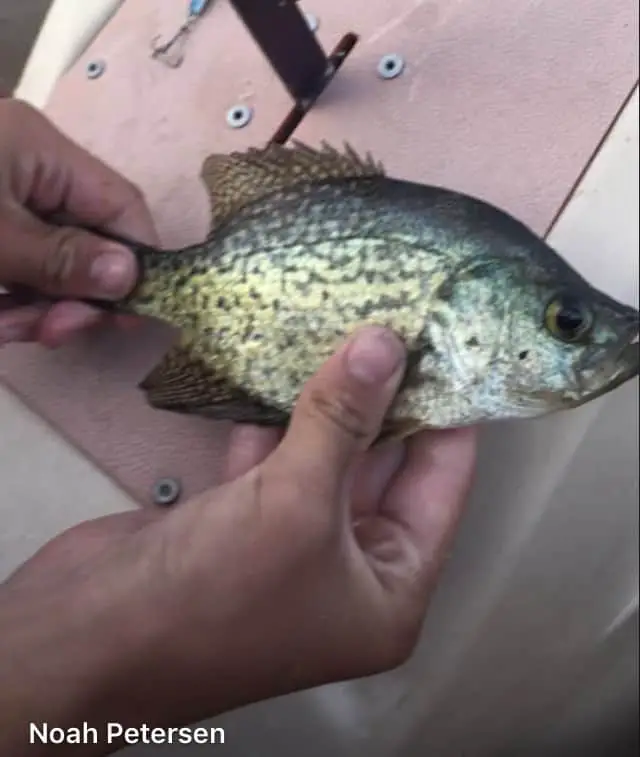If you are a fishing sportsman, then chances are you just love getting out there on the lake or river and fishing for your favorite species of fish. Naturally, if there is anything that is at least the second-best to this, it would have to be the practice of eating what you catch. There is no question that most sportsmen will eat what they catch from time to time, and this includes almost all species of fish. Of course, if you are going to eat your catch, you also need to be aware of just how many bones that particular species of fish might have.
Of course, this begs the question, what if you are trying to catch crappie? Yes, they are known as a panfish, meaning they will grow past the size of your cooking pan, but do they have a lot of bones? The best way to determine that is just to simply compare them to other types of fish. Read on to learn just how they stack up against other fish:

Are you seriously looking turn your hobby into a business? I recommend joining Income School. I’ve been an Income School member for a little over a year and joining was the best decision I’ve made in working toward my business goal of making money online.
Crappie vs. Bass
In my experience, crappie and bass are very similar. First of all, when you look at filleting bass, the first thing you are going to notice is that there are a lot of small rib bones to deal with. However, all you have to do is simply cut out the ribs outright in order to properly fillet the bass.
Interestingly enough, the crappie is much like the bass, except that it is a bit smaller, thus making the bones a little bit more concentrated. Of course, when you are talking about the larger crappies, it really isn’t that difficult to cut out all of the bones. However, the smaller ones will have rib bones that are quite sharp, so if you are planning on eating smaller crappie, you will need to know what you are doing.
Here are some good hooks for crappie fishing. size 8-12 is great!
Crappie vs. Trout/Walleye/Pike
When you are comparing crappie and trout, walleye, or pike, one of the things that you immediately notice is that these other three species are actually MUCH worse when it comes to their rib bones. The trout, pike, and walleye actually have an IMMENSE amount of rib bones. Are they a tasty species? Absolutely. But you are going to be tearing your hair trying to get rid of all of the rib bones in these three. Thus, there is no question that the bones of the crappie are much easier to deal with.
If you have social media or a blog or even a business in fishing like a fishing guide, you can make money by giving away $10 store credit to your friends and followers. Click Here to find out how
Crappie vs. Bluegill
In most cases, a crappie will have a much easier bone structure than a bluegill. Really, unless you are very experienced at dealing with bones, it is better if you throw a bluegill back than try to fillet. Part of the reason for that is because the bluegill has some very sharp rib bones. Yes, the bluegill is every bit as delicious as the crappie, but it will definitely be a chore cutting out those rib bones. Considering that Crappie is similar to the Bluegill, you should just go with them instead. However, there is one small caveat here, however. Yet again, if you do not catch a large enough crappie, there are some individuals who claim that their rib structure is just as complicated as a bluegill and every bit as sharp.
So…Do Crappie Have a Lot of Bones? Yes or No?
Of course, all of this comparison brings us to the crux of the matter, and hopefully an answer to the question in the title. Do crappie have a lot of bones? The answer seems to be that they are kind of in the middle. No, they usually don’t have as many bones as a bluegill, trout, walleye, or pike, but there are a few fish that are easier to deal with. For example, although they weren’t mentioned, one of the best fish to deal with for beginners in terms of bone structure would have to be catfish. But anyway, for the most part, we can probably safely say that no, crappie don’t have that many bones. However, it’s not so much the AMOUNT of bones that a particular fish species has so much as it is the way the bones are DESIGNED.
Of course, now that you have a general idea of how many bones that a crappie’s body might have, you are probably wondering about some basic steps you can take in order to properly cook a crappie meal. Here are some of the steps that you need to keep in mind:
Gather up all of your needed tools.
In order to properly fillet a crappie, there are actually quite a few tools that you will need. First of all, you will need a good cutting board along with a plastic or glass surface so that you can properly dispose of the bacteria. You will also need a trash bag and some good household bleach in order to clean everything up appropriately.
Start the first cut.
Lay the fish on a cutting board or other such type of hard surface. Then, you should take the fillet knife to the side (pectoral) fine of the crappie. The best way to do this is by grasping the fish’s mouth. You also should slice downward against the backbone, and be sure to keep the rear of the knife blade up as well. Be especially careful that you don’t cut into the backbone of the fish.
Aim the knife blade in the direction of the tail.
Do your best to continue cutting, and make sure that you stay on top of the back and the belly fins as well. Don’t panic if you feel some resistance when you cut through the rib cage. However, at the same time you shouldn’t cut into the backbone. Cutting too shallow is always a better idea than cutting too deep. Keep cutting toward the tail until you have nearly cut off the scaly fillet portion off.
Hey FISHMONGER – make sure to check out my FISHING RESOURCES page.
Flip the fillet away from the fish.
The next step would be to flip the fillet away from the fish. Position it so that it is on the narrow portion of the fillet, and slice between the meat and the skin so that you have removed the fillet. If you want the maximum meat, you should make your cuts as close to the skin as possible. Once you have removed the fillet, place the fillet and the rib cage on a sheet of wax paper. Now it’s time to flip over the fish and fillet the other side as well.
Finally, all you have to do is rinse the fillets, and then you can either cook them or store them.
So you see, while the crappie does indeed have their share of bones, as long as you know what you are doing, you can still use this species as a nutritious meal for you and your family.

